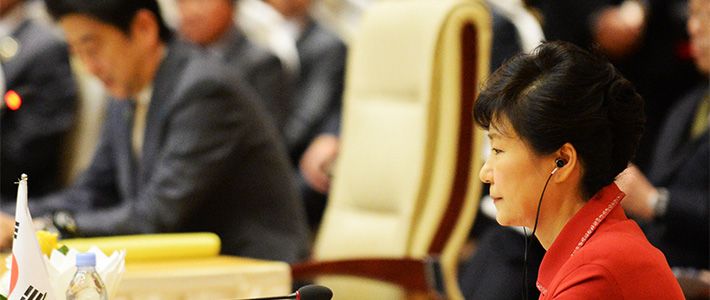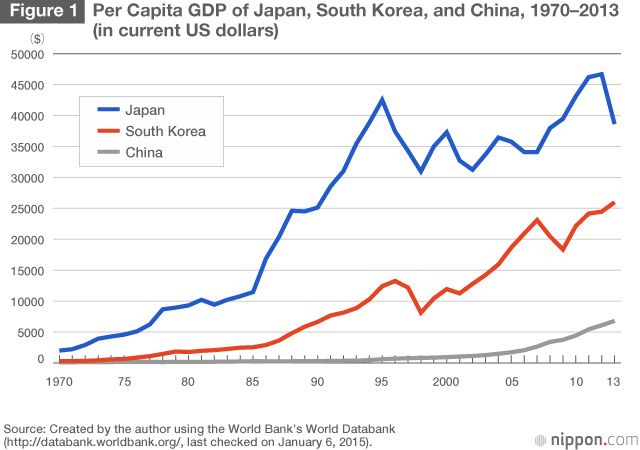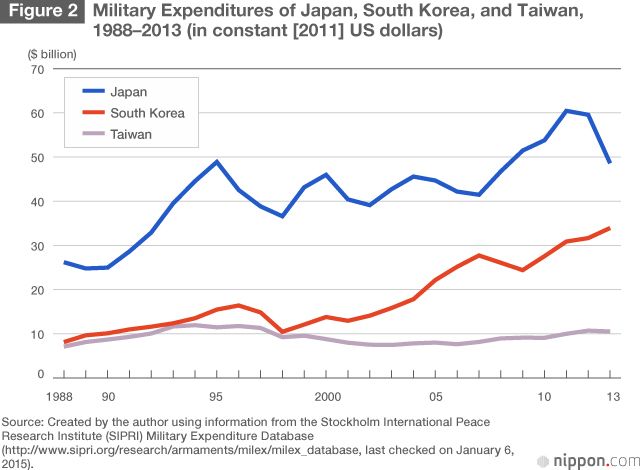
Japan and South Korea: Time to Build a New Relationship
Politics- English
- 日本語
- 简体字
- 繁體字
- Français
- Español
- العربية
- Русский
1915–65: The Map of the World Is Redrawn
The Treaty on Basic Relations Between Japan and the Republic of Korea was concluded in 1965. So as of this year, half a century has elapsed since the normalization of relations between Japan and South Korea. To help us understand just how long an interval this is, I suggest that we turn our eyes back another 50 years to the previous half century, the years from 1915 to 1965, and consider the changes that occurred over the course of that period.
As of 1915, only five years had passed since the start of Japan’s colonial rule over the Korean Peninsula. And it was four years later that the biggest Korean independence movement of the colonial period, the March 1st Movement of 1919, broke out. On the global scene, meanwhile, World War I was raging, with the five great powers of Europe—Austria-Hungary, Britain, France, Germany, and Russia—locked in mortal combat. Three of these powers, namely, Austria-Hungary, Germany, and Russia, were still maintaining old systems of government far removed from Western democracy. The United States was a newly emerging power that was not yet part of the inner circle of great nations. Large parts of Asia and Africa were under the colonial rule of the Western powers, and the superiority of whites over colored people was asserted as a matter of course.
As of 1965, a half century later, the world was a very different place. In Europe, the Russian Revolution of 1917 had led to the establishment of the Soviet Union in 1922, and the end of World War I in 1918 was followed by the breakup of the Austro-Hungarian Empire and the establishment of many independent new states in Eastern Europe. Germany, after experiencing two decades of postwar tumult, had started World War II in alliance with Italy and Japan. The United States and the Soviet Union had emerged as the two main victors of this second global conflict, and their rivalry had developed into the Cold War between their respective blocs. Exhausted by World War II, Britain and France had given up their colonial empires, and numerous independent new states had been born in Africa and in Asia, including North and South Korea and the countries of Southeast Asia. And the Communists’ victory in the Chinese civil war had been followed by the establishment of the People’s Republic of China. So the map of the world as of 1965 was strikingly different from what it had been 50 years earlier.
1965–2015: Changes of Substance in the International Order
By comparison with 1915–65, the changes in the global map over the half century from 1965 to 2015 appear relatively minor. Particularly here in East Asia, about the only notable development over this period was the unification of North and South Vietnam; otherwise the nations of the region have basically continued to exist within the same borders. Even the end of the Cold War, which resulted in a dramatic transformation of the international framework in Europe, did not affect the legacy of division between North and South Korea and between China and Taiwan.
This does not mean, however, that the past 50 years have been without major changes in East Asia and elsewhere around the world. If the half century before 1965 was a period of changes of framework accompanied by shifts in national borders, the half century since then has been a period of changes of substance within the existing framework. As of 1965, the former colonial powers still wielded overwhelming power, and the developing nations, consisting largely of former colonies, were still subordinate to them in both the economic and political spheres. But in the world of 2015, the erstwhile great powers do not have such a dominant position. As seen in the shift from the Group of Seven, the exclusive club of advanced nations formed in 1970, to the much broader Group of 20, the old powers no longer enjoy the overwhelming lead they formerly held in the economic realm—or even in terms of military might. And the dividing line between advanced and developing nations has become blurred.
Japan–South Korea Relations as a Microcosm of Global Politics
Relations between Japan and South Korea since the normalization of ties in 1965 have naturally taken place in this same context of global change. In fact, the bilateral relationship can be seen as a microcosm of the global dynamic in international relations over the past half century, featuring one country, Japan, that was the last of the imperialist powers in the years before World War II, and another, South Korea, that was the front-runner among the NIEs, the newly industrializing economies that started surging ahead in the 1980s. This will be easier to see if we compare the relative positions of the two countries as of 1965 and today.
The Japan of 1965 had hosted the Olympic Games the previous year, the first non-Western country ever to do so, and it had also gained admission to the Organization for Economic Cooperation and Development, known as the club of the rich industrialized nations. Bullet trains were already whizzing between Tokyo and Osaka, and the economy was also speeding ahead, with a nominal growth rate of well over 10% a year. Just three years later, in 1968, Japan topped West Germany in terms of gross domestic product, making its economy the world’s second biggest. On the political front, meanwhile, the ruling Liberal Democratic Party, benefiting from the tailwind of economic growth, had built a solid majority in the National Diet and was on its way to establishing its long-term hold on power.
In South Korea, meanwhile, though 12 years had passed since the end of the Korean War, times were still hard in many respects. The country’s per capita GDP had barely reached $100 as of 1965, only about one-seventh of Japan’s figure. Even more serious was the state of the country’s trade structure. Total exports for the year, at $175 million, were far short of total imports, at $463 million, and South Korea was forced to depend on financial assistance from abroad to cover its big trade deficit.
On the military front, even after the Chinese pulled out of the Korean Peninsula, the North continued to boast much greater might than the South. And the United States, the ally on which South Korea was relying for its security, was turning its gaze from that country to Vietnam, where warfare was escalating. Park Chung-hee, the South Korean leader who had taken power in a coup d’état in 1961, did not enjoy strong support from the public, as seen in the narrow margin of 1.5% by which he defeated the opposition candidate in the 1963 presidential election. So the political situation also remained unstable.
The 1965 basic treaty normalizing ties between Tokyo and Seoul was a product of the bilateral relationship of the time, a relationship that was vertical in nature. The United States, facing the burden of the escalating conflict in Vietnam, was cutting back on its assistance to South Korea, and the government in Seoul urgently needed to find a source of foreign currency to make up the shortfall. This was what drove the Park Chung-hee administration to shift from the hard line it had been taking toward Tokyo and make major concessions to the Japanese side. In the talks that led to the conclusion of the basic treaty, South Korea yielded not just on the amount of foreign currency Japan would provide but also the appellation under which the funds would be provided—agreeing to accept the money in the form of “economic cooperation” rather than as reparations for Japan’s colonial rule.
From a Vertical to a Horizontal Relationship
Over the course of the half century from 1965 to the present, the formerly vertical relationship between Japan and South Korea has undergone a great transformation. One element of this is the shrinking of the economic gap between the two countries. Figure 1 shows the per capita GDPs of Japan, South Korea, and China as measured in US dollars from 1970 through 2013. As we can see from this graph, thanks to its rapid economic growth since the 1980s, South Korea, formerly one of the poorest countries of the Far East, has reached the point of joining the ranks of the advanced countries. The transformation is also evident in the structure of South Korea’s trade. The trade deficits that the country recorded for many years have become a thing of the past; since 2009 it has been earning surpluses, and they have been growing from year to year.

The relative status of the two countries has also changed on the military front. Figure 2 presents the military expenditures of Japan, South Korea, and Taiwan since 1988. South Korea’s military spending is close to 3% of GDP, a relatively high level, and with the rise of its currency, the won, in recent years, the total has been rapidly approaching Japan’s. Though the nature of the two countries’ military outlays differs, it is clear that the gap between them has been closing in this area as well.

So it is evident that over the past 50 years what was formerly a vertical relationship between Japan and South Korea has become a more horizontal one. This is why we have seen a sudden upturn in moves seeking to revise the “old” Japan–South Korea relationship as based on the 1965 basic treaty. In recent years South Korea’s Supreme Court has come out with decisions that at first glance seem to be clearly contrary to the provisions of the 1965 treaty with respect to cases involving the comfort women and those subjected to forced labor. Unlike her predecessors, President Park Geun-hye adopted a hard line toward Japan on the history issue right from the start of her administration. The change in the bilateral relationship underlies developments like these.
An International Arbitration Board to Review the Old Relationship
How should we deal with this situation? The first point we should make clear is that reviewing the old relationship between Japan and South Korea must not mean going back to the starting line. The 1965 basic treaty took 14 years to conclude, measuring from the start of preparatory discussions. As this indicates, it would be no easy matter to formulate a comprehensive new pact from scratch between the two countries, which have knotty differences with regard to territorial issues and historical perceptions. And we certainly cannot put bilateral ties on hold while a new round of negotiations is underway, since the two countries are growing increasingly interdependent on various levels.
At the same time, however, we must acknowledge the hopelessly wide gap that has emerged in the two countries’ views of the 1965 framework, as seen in the contrast between the rulings of Japanese and South Korean courts on the issues of the comfort women and forced labor during World War II. When the two countries’ courts come out with conflicting rulings, their respective governments are legally bound to follow them, and as a result they have less room to negotiate on the issues. In this context, it is virtually impossible to hope that the situation will improve by itself if we put off dealing with it.
So it is essential at this point for Japan and South Korea to forthrightly discuss the framework of their 1965 relationship. The rulings of their courts have limited the options for the two countries’ governments, however, so we need to turn to the international community for help. One idea would be to establish an arbitration board, as stipulated under an annex to the 1965 basic treaty (the Agreement on the Settlement of Problems Concerning Property and Claims and on Economic Cooperation Between Japan and the Republic of Korea) to settle differences of interpretation.
Building a New System for Better Bilateral Ties
If the idea of setting up a formal arbitration board under the provisions of this agreement is considered too difficult in practical terms or too risky in political terms, another option would be to set up a commission or other sort of panel to operate as a “track two” initiative. International judicial arbitration bodies like the International Court of Justice and official arbitration boards are no more than groups of prominent scholars of international law and former diplomats, and it would certainly not be difficult to assemble a similar group as a “pseudo arbitration board.” We might be able to use the judgments of such a board as a tool for pushing the courts and the general public in the two countries toward consensus and building a new bilateral relationship. At the very least, the findings of such a board would provide valuable reference materials to help the two countries’ courts, governments, and above all their people to see how the rest of the international community assesses the debate they are currently conducting. It would also give the administrations in Tokyo and Seoul, both of which are now immobilized by hard-line domestic public opinion, a crucial opening for a shift of course.
Above all, it is essential for us at this point to take a straightforward look at the current state of the bilateral relationship built on the 1965 basic treaty, which, with the passage of a half century, has ceased to function properly, and to look earnestly for ways of fixing it. The world today is one in which relationships that were formerly vertical are becoming horizontal, and this leveling process gives rise to many new problems. In that respect, the relationship between Japan and South Korea is a microcosm of today’s world.
In the context of the major changes taking place in international relations, how can we build a new system that will allow us to maintain the stability formerly provided by the old set of arrangements? Finding an answer to this question will be a test of our wisdom.
(Originally published in Japanese on January 21, 2015. Title photo: South Korea’s President Park Geun-hye and Japan’s Prime Minister Abe Shinzō at the November 2014 ASEAN+3 summit in Myanmar. © Xinhua/Aflo.)
China LDP Korea Cold War World War II comfort women International Court of Justice Park Chung-hee Prime Minister Abe Seoul Kimura Kan NIEs President Park Geun-hye